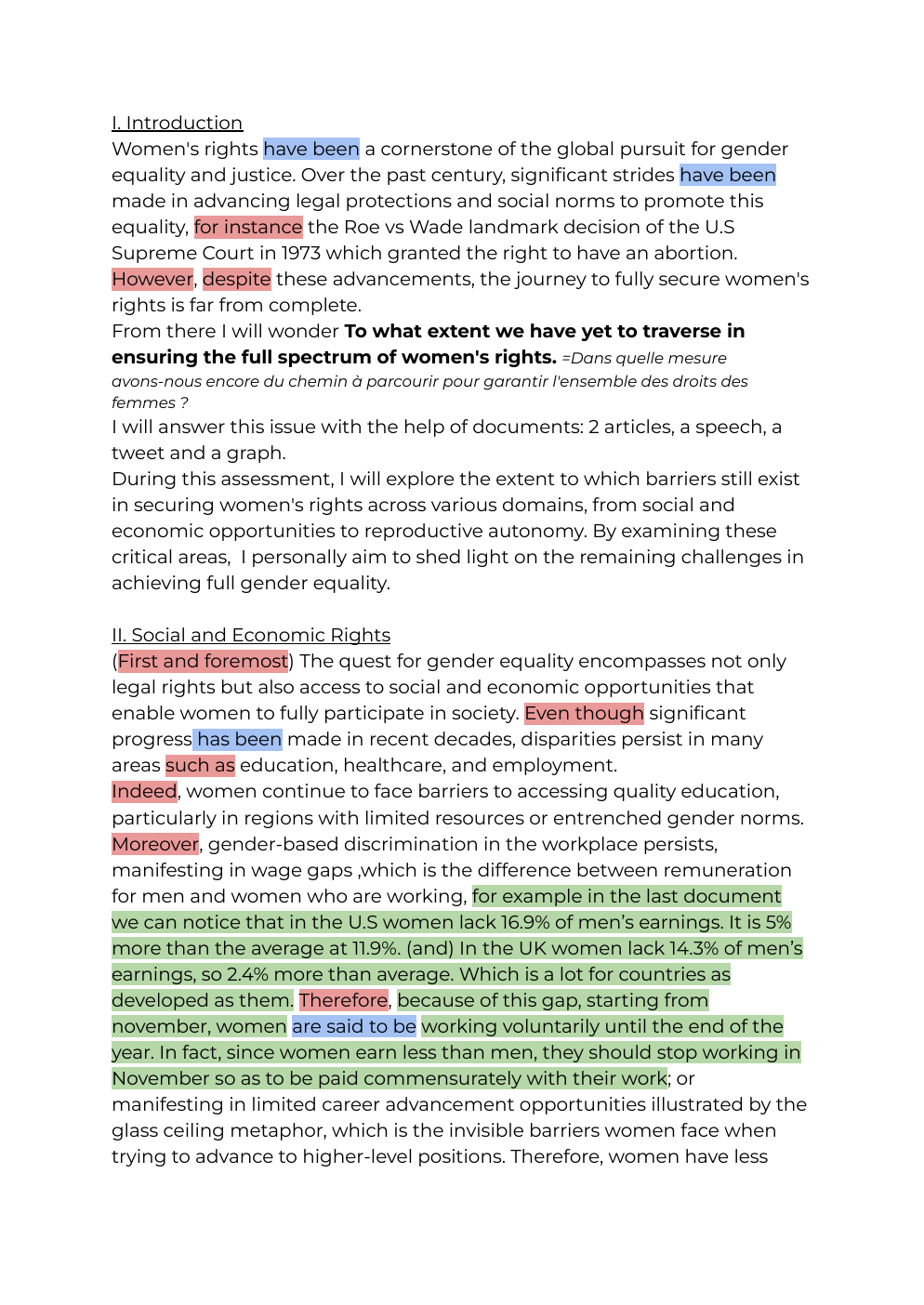I will wonder to what extent we have yet to traverse in ensuring the full spectrum of women’s right
Publié le 22/06/2025
Extrait du document
«
I.
Introduction
Women's rights have been a cornerstone of the global pursuit for gender
equality and justice.
Over the past century, significant strides have been
made in advancing legal protections and social norms to promote this
equality, for instance the Roe vs Wade landmark decision of the U.S
Supreme Court in 1973 which granted the right to have an abortion.
However, despite these advancements, the journey to fully secure women's
rights is far from complete.
From there I will wonder To what extent we have yet to traverse in
ensuring the full spectrum of women's rights.
=Dans quelle mesure
avons-nous encore du chemin à parcourir pour garantir l'ensemble des droits des
femmes ?
I will answer this issue with the help of documents: 2 articles, a speech, a
tweet and a graph.
During this assessment, I will explore the extent to which barriers still exist
in securing women's rights across various domains, from social and
economic opportunities to reproductive autonomy.
By examining these
critical areas, I personally aim to shed light on the remaining challenges in
achieving full gender equality.
II.
Social and Economic Rights
(First and foremost) The quest for gender equality encompasses not only
legal rights but also access to social and economic opportunities that
enable women to fully participate in society.
Even though significant
progress has been made in recent decades, disparities persist in many
areas such as education, healthcare, and employment.
Indeed, women continue to face barriers to accessing quality education,
particularly in regions with limited resources or entrenched gender norms.
Moreover, gender-based discrimination in the workplace persists,
manifesting in wage gaps ,which is the difference between remuneration
for men and women who are working, for example in the last document
we can notice that in the U.S women lack 16.9% of men’s earnings.
It is 5%
more than the average at 11.9%.
(and) In the UK women lack 14.3% of men’s
earnings, so 2.4% more than average.
Which is a lot for countries as
developed as them.
Therefore, because of this gap, starting from
november, women are said to be working voluntarily until the end of the
year.
In fact, since women earn less than men, they should stop working in
November so as to be paid commensurately with their work; or
manifesting in limited career advancement opportunities illustrated by the
glass ceiling metaphor, which is the invisible barriers women face when
trying to advance to higher-level positions.
Therefore, women have less
professional opportunities than men, simply because they are women.
Furthermore, the housework gender gap persists as well and just like it is
said in the second article l.12 “if you’re a woman living with a man, it’s
highly likely you end up doing most of it, no matter who earns more, or....
»
↓↓↓ APERÇU DU DOCUMENT ↓↓↓
Liens utiles
- To what extent can social media be a tool for the public to have their say in political matters
- What are the influences of the Gilead society and how they have an impact on the woman’s lives?
- WHAT THE?
- To what extent are music festivals political ?
- HEAVY BOOTS HEAVIER BOOTS Twelve weekends later was the first performance of Hamlet, although it was actually an abbreviated modern version, because the real Hamlet is too long and confusing, and most of the kids in my class have ADD.


